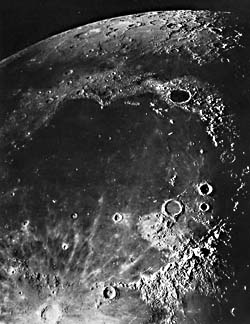 |
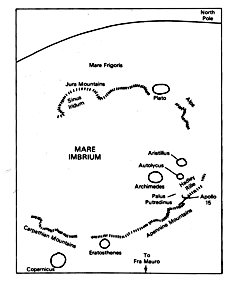 |
|---|---|
| Plate P-2 | Map |
 |
 |
|---|---|
| Plate P-2 | Map |
This view of Mare Imbrium, taken several decades ago with the 100-inch Mount Wilson telescope, is more valuable than ever because of the Apollo 15 mission, which landed at the foot of the Apennine Mountains. The two major divisions of the lunar surface, maria and highlands, are well displayed here. The maria as such will be covered in Plate P-3. This photo covers a circular mare (Imbrium itself) and parts of several irregular maria (Frigoris, Procellarum, Sinus Roris, and Sinus Aestuum). The lunar highlands, at top, are a mosaic of crater on crater, formed by impacts in the Moon´s earliest crust. The highlands constitute most of the Moon´s total area and underlie the mare basalts.
The most useful way to discuss the landforms of this area is to trace the evolution of the Imbrium area, using superposition and absolute dates from radiometric analyses. The first landforms produced were the impact craters of the highlands, excavated in a crust probably formed by igneous processes 4 to 4.5 billion years ago (Taylor, 1982). Most of this area resembled the northern highlands before the Imbrium Basin were formed.
| Figure P-2.1 | Figure P-2.2 |
|---|---|
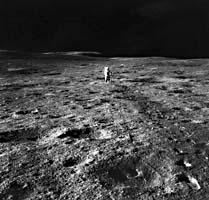 |
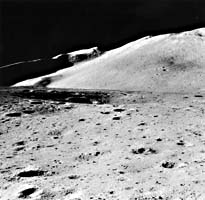 |
The Imbrium Basin is essentially a very large impact crater. As visualized by Baldwin (1965), an asteroidal body probably a few tens of kilometers in diameter struck the Moon, producing a flash of light and throwing out an immense cloud of ejecta now forming the mountains ringing the basin. The Apennines are especially well displayed here. They grade into the Fra Mauro formation on which the Apollo 14 mission landed just off the Plate scene to the south (see Figure P-4.2). Radiometric dates of Fra Mauro samples indicate a major thermal event 3.8 billion years ago, presumably the Imbrium impact. The terrain at the Apollo 14 landing site is clearly shown in Figure P-2.1.
The catastrophic impact produced a raised rim, visible in cross section in Figure P-2.2, looking south along the Apennine Front from the Apollo 15 spacecraft. The prominent ledge at left, Silver Spur (20 km away), shows gently dipping strata whose nature and origin are not understood. They may be layers of ejecta from pre-Imbrium impacts, or they may be some sort of igneous feature. The rounded topography of Silver Spur, formed in what on Earth would be the early Archean, shows the extremely slow pace of lunar geomorphic processes.
Returning to the telescopic view, one can reconstruct the major postimpact stages in the evolution of Mare Imbrium. There was a short stage in which walls of the initial megacrater slumped back toward the depression. This is most obvious along the Apennine Front (lower right), which is basically a series of normal fault scarps. In the Apollo 15 orbital view (Figure P-2.3), one sees a number of concentric grabens representing postimpact tension fracturing. These grabens cut probable impact melt south of Autolycus, but not the mare basalts of the Palus Putredinus, and thus must be between 3.8 and 3.3 billion years old (the latter being the age of basalts from Hadley Base).
| Figure P-2.3 |
|---|
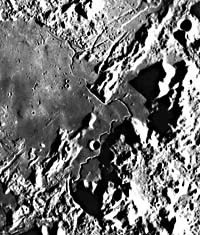 |
Another series of events involved the formation of several large craters, including Plato, Archimedes, and Sinus Iridum. These craters are obviously older than the Imbrium Basin, but older than the mare basalts. This physiographic relationship shows that the mare material could not be a simple impact melt.
Another interesting landform (also in Figure P-3.2) is Hadley Rille. It has been proposed that sinuous rilles of this sort are fluvial erosion channels dating from a time when the Moon had running water. This theory can now be discarded in view of the totally anhydrous nature of all lunar rocks sampled thus far. Another and more likely theory proposed by Cameron (1964) is that they were formed by ashflows; however, this proposal is weakened by the apparent absence of true ignimbrites on the Moon. The most likely theory, from both geomorphic and petrologic evidence, is that these rilles are unroofed lava tubes formed by drainage of the still-molten basalt (Greeley, 1971).
After the eruptions of mare basalt ceased, roughly 3 billion years ago, the internal evolution of Mare Imbrium was essentially complete. However, many spectacular impact craters have formed since then, so that few if any places on the Moon are free from the effects of impact. The Apollo 15 surface view (Figure P-2.2) gives a good closeup of the regolith formed on mare basalt by 3 billion years of small impacts. View 263, Mount Wilson Observatory.
Continue to Plate P-3| Chapter 10 Table of Contents.| Return to Home Page| Complete Table of Contents|